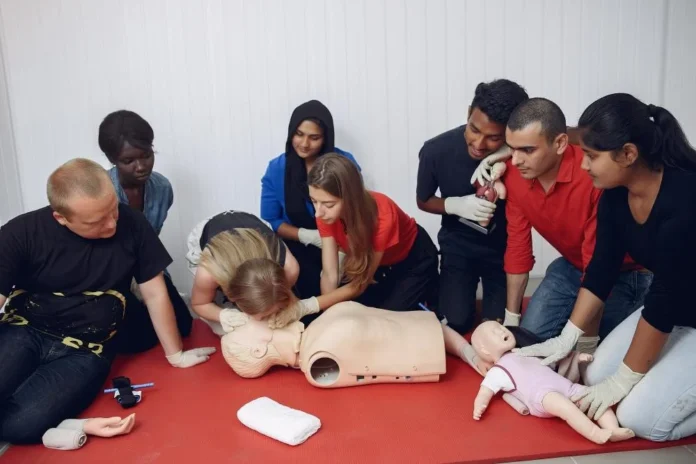A safe workplace is a productive one. Every employer wants a team that feels secure, confident, and prepared for anything. But accidents happen. A colleague might choke on lunch, trip over a cable, or suffer a sudden medical emergency. Would the team know what to do?
This is where first aid training becomes invaluable. It’s not just about ticking a health and safety box—it’s about creating a culture of care, confidence, and readiness. First aid training equips employees with the skills they need to respond swiftly in an emergency.
Here are seven powerful reasons why first aid training is an essential skill every team should have.
1. Enhances Safety Awareness
Workplace accidents often happen due to a lack of awareness. Many employees don’t notice hazards until it’s too late. A simple misplaced coffee spill, loose wires, or an unstable chair could lead to a serious injury.
Providing awareness training changes that. Employees become more observant, recognizing risks before they turn into incidents. They learn to spot potential dangers, fix small hazards, and report concerns promptly.
A trained team is a vigilant team. They don’t just react to emergencies—they help prevent them.
2. Promotes Quick Response to Incidents
In an emergency, every second counts. A delay in response could mean the difference between a minor injury and a life-threatening situation.
First aid training ensures that employees act fast and effectively. They won’t stand frozen in panic or waste precious time figuring out what to do. Instead, they’ll assess the situation, provide immediate care, and call for professional help if needed.
A trained employee knows how to stop severe bleeding, perform CPR, or handle burns. Immediate response can reduce pain, prevent complications, and even save lives.
Enrolling in an online first aid at work course provides essential knowledge on responding to cuts, burns, CPR, electric shocks, and more. While it doesn’t replace hands-on training, it reinforces crucial first aid techniques.
3. Helps Reduce Workplace Accidents
Many accidents happen due to carelessness or lack of knowledge. Slips, falls, and minor mishaps can escalate when employees don’t know how to prevent them.
With first aid training, employees become more safety-conscious. They learn about hazard prevention, safe practices, and emergency procedures. This knowledge reduces the likelihood of workplace injuries.
Imagine a worker noticing a wet floor with no warning sign. Instead of ignoring it, they’ll clean it up or report it before someone gets hurt. Small actions like this lead to fewer workplace accidents and a safer environment for everyone.
4. Boosts Employee Confidence
Emergencies can be overwhelming. Without proper training, employees might panic, hesitate, or make the wrong call. But with proper training, they gain the confidence to act decisively.
Knowing how to handle situations like heart attacks, allergic reactions, or fainting gives employees peace of mind. They don’t have to second-guess their actions. Instead, they step in with calmness and efficiency.
This confidence extends beyond the workplace. Employees take these life-saving skills home, ready to help family, friends, and even strangers in public.
5. Compliance with Health and Safety Regulations
UK workplaces must meet health and safety regulations, and first aid training plays a key role in compliance. The Health and Safety (First-Aid) Regulations 1981 state that employers must provide adequate first aid training and facilities.
Failing to comply can lead to legal consequences, fines, or even lawsuits if an accident occurs. Having trained first aiders not only ensures compliance but also reduces liability risks.
A well-trained team protects not just employees but also the business itself. It demonstrates a commitment to safety and responsibility.
6. Improves Employee Wellbeing
A safe workplace isn’t just about accident prevention—it’s also about employee wellbeing. Knowing that colleagues are trained in first aid creates a sense of security.
Employees feel valued and protected, reducing stress and anxiety. This is especially important in high-risk environments where injuries are more likely to occur.
First aid training also extends beyond physical health. Many first aid courses now include mental health support. Given the rise in work-related stress and anxiety, this is an essential skill for creating a healthier, happier workforce.
7. Enhances Team Building
First aid training isn’t just about learning—it’s also about bonding. When employees train together, they build trust, improve communication, and develop teamwork skills.
Learning how to support one another in an emergency fosters a sense of unity. Employees see each other in a different light—not just as colleagues but as people who have each other’s backs.
These sessions can even bring out hidden leadership skills. Some employees naturally step up, take charge, and guide others in emergency situations. First aid training strengthens not only individual skills but also the team as a whole.
First aid training is not optional—it’s essential. It enhances safety, reduces accidents, improves wellbeing, and strengthens team dynamics. A trained workforce is confident, prepared, and capable of handling emergencies with skill and composure.
Every workplace should consider a first aid course as part of its professional development programme. The benefits far outweigh the costs. After all, nothing is more valuable than saving a life.
Investing in first aid training keeps your workplace safe, your team confident, and your business prepared for emergencies. Stay informed with more workplace safety insights at InsightsJournal.



